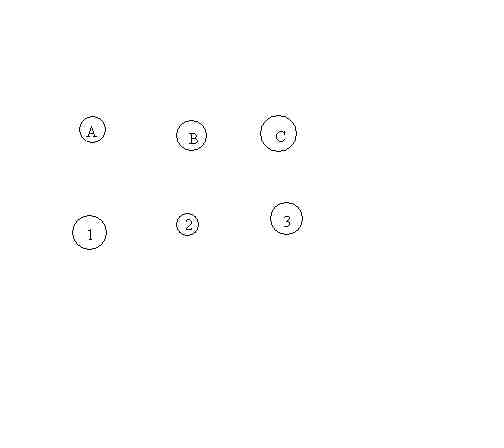Applications of Topology to Geometry
Konigsburg Bridges
Classification
of Platonic Solids
Topological/Graph Theory Proof.
Euclid: "I say next that no other figure, besides the
said five figures, can be constructed which is contained by equilateral
and equiangular figures equal to one another."
Proof:
Consider the number of vertices (V>3), edges (E>3), and
faces (F>2) involved in the figure.
Since the figure is topologically equivalent to the sphere,
V+F=E+2.(*)
But the assumption is that the number of edges on each face
is the same... call it k
and that the number of edges meeting at each vertex is
the same... call it l.
Thus we have kF=2E
and lV=2E.
Putting this together with (*) we have 2E/l +2E/k
= E + 2, or
1/l
+ 1/k
= 1/2 + 1/E.
Here is a table showing the only
possible integer values that satisfy this equation and therefore
there can be only 5 corresponding regular convex polyhedra- the five platonic
solids:
|
|
V |
F
|
E
|
k
|
l
|
|
Tetrahedron
|
4 |
4
|
6
|
3
|
3
|
|
Cube
|
8 |
6
|
12
|
4
|
3
|
|
Octahedron
|
6 |
8
|
12
|
3
|
4
|
|
Icosahedron
|
12 |
20
|
30
|
3
|
5
|
|
Dodecahedron
|
20 |
12
|
30
|
5
|
3
|
Konigsburg Bridges
Utility Problem
The classical "utility problem" or "cranky neighbour problem"
asks
whether it is possible for three houses (A, B, and C)
each to be
connected to three utility plants (1, 2, and 3) without
having any of
the lines cross.
 This problem is impossible to solve in the plane (but not
on a torus).
This problem is impossible to solve in the plane (but not
on a torus).
Proofs of the impossibility can be based on the Jordan
Curve Theorem or by a counting argument based on Euler's Formula.
[V+F=E+2.(*)]
Here is the proof based on Euler's
Formula briefly:
If the problem can be solved
then it would form a planar graph with V=6 and E=9.
Thus there would have to be
exactly 5 regions (including the unbounded region of the plane in the graph).
Each of these regions must have
at least 4 edges. Since each edge can be counted twice once for each region
it bounds-there will be at least 10 edges in the graph. BUT we only have
9 edges!